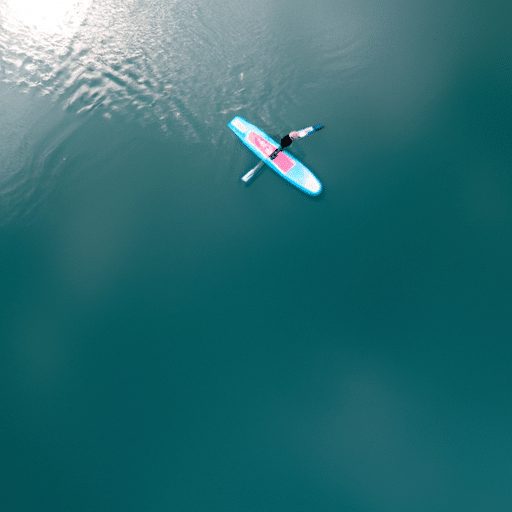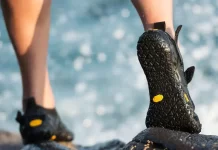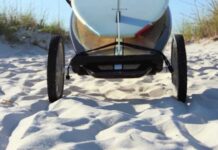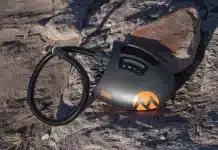In our quest to find the ideal paddle blade shape for Stand-Up Paddle (SUP) boarding, we’ve explored various options, testing their efficiency and performance on the water. As we navigate the vast world of paddle boarding, we aim to answer the ever-pervasive question: which paddle blade shape reigns supreme?
So, join us as we embark on this fascinating journey, uncovering the secrets behind paddle blade shape and its impact on our SUP boarding experience. When it comes to paddling blade shape options for SUP boarding, there are several choices available that can greatly impact your paddling experience.
Each blade shape offers its advantages and disadvantages, so it’s essential to understand their differences to make an informed decision. In this article, we will explore the various blade shapes, their definitions, pros, cons, and factors to consider when selecting the right blade shape for your needs.
Symmetrical Blade Shape
The symmetrical blade shape refers to an identical paddle on both sides, creating a balanced and even surface area. This shape is the most commonly used and versatile among paddleboarders.
Definition
A symmetrical blade shape means that both the top and bottom sections of the blade are equal in shape and size. It has a uniformly distributed surface area, providing stability and predictable performance.
Pros
The symmetrical blade shape offers equal power distribution on both sides, allowing for efficient paddling in any direction. This balance benefits beginners or individuals seeking a more straightforward and consistent stroke.
Cons
While the symmetrical blade shape provides reliable performance, it may lack the specialization of other blade shapes. It may not be as effective in specific conditions, such as strong winds or waves, where more specialized blade shapes excel.
Asymmetrical Blade Shape
The asymmetrical blade shape is characterized by a distinct curvature, with one side larger and more pronounced than the other. This design helps to optimize paddle efficiency, especially when paddling on one side.
Definition
An asymmetrical blade shape means that one side of the blade is larger and more pronounced than the other. The larger surface area creates more power and control when paddling on the side with the larger face.
Pros
The asymmetrical blade shape increases efficiency and power when paddling on one side, making it an excellent choice for those who prefer to paddle with a dominant hand. It allows for more precise maneuvers, enhanced tracking, and reduced fatigue.
Cons
While the asymmetrical blade shape excels in efficiency on one side, switching sides may require more excellent skill and adaptability. Paddlers must develop proficiency in blade control to achieve optimal performance when transitioning between strokes.
Dihedral Blade Shape
The dihedral blade shape is characterized by a pronounced ridge running down the blade’s center. This ridge creates a concave shape, providing stability and better tracking in the water.
Definition
A dihedral blade shape has a central ridge that creates two distinct faces. This design helps to reduce blade flutter and enhances stability by directing water flow more efficiently.
Pros
The dihedral blade shape offers excellent stability and tracking, reducing the chances of paddle wobbling or fluttering during each stroke. It allows for smoother paddling and better controls, making it suitable for various water conditions.
Cons
While the dihedral blade shape provides stability, it may sacrifice some power compared to other blade shapes. Paddlers seeking maximum power output may find other blade shapes more suitable.
Scooped Blade Shape
As the name suggests, the scooped blade shape features a curve or scoop along the bottom edge of the blade. This design helps to maximize water catch and efficiency, particularly in low-angle paddling.
Definition
A scooped blade shape is characterized by a curved or concave bottom edge that creates a cup-like shape. This design helps to increase water catch and lift, enhancing the efficiency of each stroke.
Pros
The scooped blade shape excels in low-angle paddling, where a relaxed and extended paddle stroke is desired. It allows for effortless gliding through the water, reducing fatigue and minimizing strain on joints.
Cons
While the scooped blade shape offers superb efficiency in low-angle paddling, it may not be as effective in high-angle paddling, where a more aggressive stroke is required. Paddlers who prefer high-angle paddling may find other blade shapes more suitable.
Tear-Drop Blade Shape
The tear-drop blade shape is characterized by a rounded top section that tapers down to a narrower bottom section. This design offers a versatile compromise between power and efficiency.
Definition
A tear-drop blade shape features a rounded top section that smoothly transitions into a narrower bottom section. This shape maximizes power during the initial catch and allows fluid release during recovery.
Pros
The tear-drop blade shape balances power and efficiency, making it suitable for a wide range of paddlers and conditions. It provides a smooth stroke and stable feel in the water, accommodating various paddling styles and skill levels.
Cons
While the tear-drop blade shape offers versatility, it may not excel in specialized conditions where specific blade shapes could provide a more optimized performance. Paddlers with specific paddling goals or preferences may opt for other blade shapes for enhanced performance.
Now that we have covered the various blade shapes and their respective pros and cons let’s delve into the critical factors one should consider when choosing the right blade shape for their SUP board:
Factors to Consider
Paddler’s Skill Level
The paddler’s skill level is crucial in selecting the right blade shape. Beginner paddlers may benefit from a symmetrical blade shape, which offers stability and predictability. More experienced paddlers can explore other blade shapes to optimize their performance and cater to their preferences.
Water Conditions
The water conditions you typically encounter should also influence your blade shape choice. A symmetrical or tear-drop blade shape may be sufficient for calm or flatwater conditions. In contrast, rougher waters or challenging conditions may require blade shapes with specialized features, such as asymmetrical or scooped designs.
Paddling Style
Different paddling styles can affect the effectiveness and comfort of specific blade shapes. Low-angle paddling, characterized by a relaxed and extended stroke, may benefit from the efficiency of a scooped blade shape. High-angle paddling, which employs a more aggressive stroke, may require blade shapes optimized for power and control, such as asymmetrical blades.
Fitness Level
A paddler’s fitness level can play a role in blade shape selection. Those with higher fitness levels may have no problem handling larger blades that offer more power. In comparison, individuals with lower fitness levels may prefer smaller blades that require less effort to paddle effectively.
These factors make choosing the right blade shape for your SUP boarding experience more manageable. It’s essential to match your blade shape to your experience level, desired usage, and personal preferences:
Choosing the Right Blade Shape
Paddler’s Experience Level
Beginner and intermediate paddlers may benefit from symmetrical or tear-drop blade shapes. These shapes provide stability, predictability, and versatility to help build paddling skills and confidence. Advanced paddlers, on the other hand, may prefer specialized shapes such as asymmetrical or scooped blades, which can provide increased efficiency and control.
Desired Usage
Consider how you plan to use your SUP board. A symmetrical or tear-drop blade shape may be suitable if you enjoy exploring calm lakes or rivers. Engaging in surf or downwind paddling may require specialized blade shapes, such as scooped or dihedral designs, to optimize performance in specific conditions.
Personal Preference
Ultimately, personal preference plays a significant role in selecting the right blade shape. Some paddlers may prioritize power and performance, while others value comfort and ease of use. Trying out different blade shapes and gathering feedback from experienced paddlers can help you determine the shape that aligns best with your personal preferences.
Alongside blade shape, the material and construction of the blade can impact your paddling experience. Here are some commonly used materials in paddle blade construction:
Blade Material and Construction
Fiberglass
Fiberglass blades are lightweight and offer excellent durability. They balance stiffness and flexibility well, allowing for efficient power transfer while reducing strain on the joints. Fiberglass blades are frequently used by intermediate to advanced paddlers, seeking high performance and reliability.
Carbon Fiber
Carbon fiber blades are known for their exceptional strength-to-weight ratio. They are incredibly lightweight, stiff, and responsive, enabling maximum power transfer with every stroke. Carbon fiber blades are favored by advanced and professional paddlers seeking uncompromising performance.
Plastic
Plastic blades are an economical option for beginners or recreational paddlers. While they may lack the same level of performance and efficiency as fiberglass or carbon fiber blades, plastic blades can still offer sufficient durability and functionality for casual paddling.
Wood
Wood blades are favored by traditionalists and paddlers seeking a unique aesthetic appeal. They offer a smooth and natural feel in the water, providing a satisfying paddling experience. Wood blades are often handcrafted, offering a blend of beauty and functionality.
When considering paddle blade size, factors such as your strength, paddling style, and desired usage come into play:
Blade Size
Large Blade
Large blade sizes provide increased power and are suitable for paddlers with greater strength and stamina. They are commonly used in surf paddling or racing situations, where quick acceleration and high power output are desired.
Medium Blade
Medium blade sizes strike a balance between power and efficiency. They are versatile and suitable for a wide range of paddlers, making them an excellent choice for recreational and general-purpose paddleboarding.
Small Blade
Small blade sizes emphasize efficiency and reduced strain on the body. They benefit paddlers with lower fitness levels or those focusing on long-distance paddling, where energy conservation is essential.
In conclusion, selecting the right paddle blade shape for SUP boarding involves considering various factors such as the paddler’s skill level, water conditions, paddling style, fitness level, desired usage, and personal preferences.
Additionally, understanding the different materials used in blade construction and choosing the appropriate blade size completes the decision-making process. By considering these factors, you can make an informed choice that enhances your SUP boarding experience and maximizes your enjoyment on the water.





































